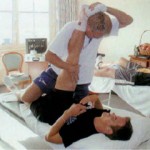Strong and flexible hamstrings are less prone to injury than hamstring muscles and tendons that are tight and weak. Below you will find some tips on how to achieve healthier hamstrings to help prevent injury or re-injury.
Use Proper Equipment and Supports
Wear appropriate athletic and/or regular shoes that are comfortable and provide significant arch support and motion control.
Utilize corrective footwear, orthotics or other foot devices provide support and alignment (check to see if you wear out the soles of your shoes on one side) and/or supportive items, such as compression shorts, braces or taping to eliminate stress on your muscles.
Modify, decrease and/or avoid activities or motions that cause pain and irritation, and ensure you always warm up and cool down before participating in activities.
Gentle massage after vigorous activities will help relax your tissues; physical therapy, acupressure, deep massage and chiropractic care are also good for more severe cases.
Maintain a Healthy Weight
Proper food and fluid intake prior to and during activities will ensure you are nourished and prevent against fatigue and dehydration.
Weight loss and/or weight maintenanceinvolves eating a balanced diet full of protein, complex carbohydrates, fats, vitamins, minerals, phytochemicals and antioxidants which will help support a healthy system. If you gain just 10 pounds, your joints must bear from 25 up to 100 pounds extra, which can add unnecessary stress to your body. Limiting your caffeine, alcohol and nicotine consumption will also improve your health.
Stretch and Warm Up Properly
Follow a stretching, strengthening, and endurance exercise routine that conditions your hamstrings, as well as your other leg muscles, lower back, gluteals and pelvis which will keep your muscles balanced, strong and limber.
Do Exercises and Appropriate Activities
If you are suffering from hamstring tendon pain, listen to your body and decrease, modify and/or avoid any activities or motions that cause pain and irritation (quick stopping/starting, turning, running or jumping, as well as participating on uneven terrain). If you are required to perform these motions at work or play and cannot avoid them, make sure you take frequent breaks and rest to prevent fatigue and pain.
Before beginning exercise or training, ask your doctor or physical therapist for a list of appropriate exercises that will not cause further harm to your weak hamstrings while you work to strengthen them.
To stabilize your hamstring and leg area, and increase your range of motion,maintain and build your strength, stability and flexibility of your hamstring, leg, gluteal, pelvis, low back and core body muscles. Light weights, exercise bands and balls are very beneficial for strengthening your lower body. Core balance training and plyometrics (exercises to develop strength, speed and agility, such as jumping or bounding movements) are also an excellent addition to your exercise routine. Yoga, tai chi, or a daily stretching routine will help to keep your muscles and joints supple (avoid sudden twisting and turning motions).
A regular exercise program that focuses on total body fitness and includes low-impact aerobic activity at least 3 days per week, such as walking, swimming or biking will help to keep you healthy overall and will strengthen your body to prevent against further hamstring injuries.
Treating Your Hamstring Tendon Injury
It is important to treat hamstring tendon injuries as soon as possible, as any activity or strain you put on your tendon can re-injure it further. Though the pain, discomfort, and inconvenience of a hamstring injury can be overwhelming, it is possible to overcome it.
The trick with any tendon injury is getting it toheal with minimal scar tissue formation. Even with optimum healing, there is always less elasticity in a previously injured tendon. This can cause the tendon to hurt during exercise and most everyday activities. However, if you heal your injured tendon efficiently and quickly, yourchance of re-injury later on is much lower.
Although it is recommended that you rest your hamstring tendons following injury it can be difficult to do as it is an essential tendon for walking and daily activities. Fortunately, there are healing tools that can help treat your tendon and speed up the healing process so you can get back to a life without pain and risk of further injury.

